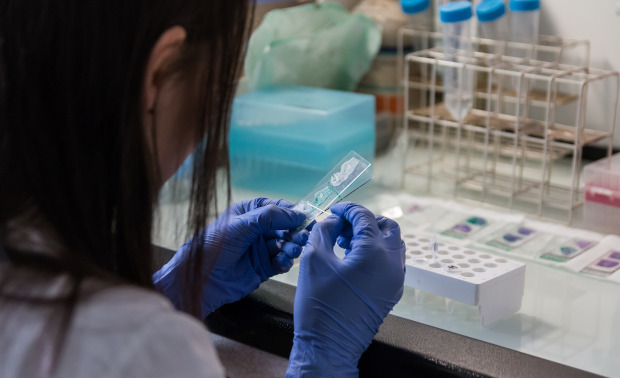We recommend screening begin at age 25 (no longer 21)
The updated guideline published today in our flagship journal, CA: A Cancer Journal for Clinicians, recommends that cervical cancer screening begin at age 25 and continue through age 65, for people at average risk, and that primary human papillomavirus (HPV) testing (without the Pap test) every 5 years be the preferred method of testing. Published along with the new guideline is a patient page.

Because these HPV tests may not be widely available in the U.S. yet, the guideline includes either of these two other acceptable screening methods and schedules:
The most important thing to remember is to get screened regularly, no matter which test you get.
The 2020 guidelines also recommend that people older than age 65 with a cervix stop being screened as long as they’ve had 10 years of regular screening with normal results. Otherwise, they should continue to be screened until they do. Cervical cancer screening may be discontinued in individuals of any age with limited life expectancy.
Those who have had their cervix removed, such as from a hysterectomy, don’t need screening as long as the surgery was done for reasons not related to cervical cancer or serious precancer.
People who have gotten the HPV vaccine should still follow the screening guidelines as listed above.
In the U.S., the expectation is that over time fewer people will have a co-test or Pap test alone as the primary HPV test become more widely available.
“When we combine improved HPV vaccination rates with the screening and treatment of precancers in the cervix, we have the potential to make history by eliminating cervical cancer,” said Debbie Saslow, PhD, a co-author of the 2020 ACS updated guideline.
The previous ACS guideline, released in 2012, called for screening starting at age 21. Since then, HPV vaccination rates have improved in the U.S. Data suggest vaccination has led to a drop in rates of precancerous cervical changes, the precursors to cancer.
Evidence shows the HPV test is more accurate than the Pap test and can be done less often; one HPV test every five years is more effective than a Pap test every three years, and even every year, as was recommended in the 1980’s and 1990’s.
Another reason for the change, is that cervical cancer incidence is low in the 20 to 24 age group. Cancer registry data from 2011 to 2015 indicates an estimated 108 cases of invasive cervical cancer in women 20 to 24 years in the U.S. each year, a number that is expected to continue to fall as vaccine use increases.
There are potential harms related to the treatment of precancerous cells identified by screening, including preterm birth, and screening has not been shown to lower the rate of cancer in women in the 20 to 24 age group. Also, most HPV infections in women in this age group become undetectable in 1-2 years. Those factors led ACS to move the recommended age to begin cervical cancer screening to 25.
How cervical cancer starts and how to find it early
The cervix connects the uterus to the vagina. It’s part of the path babies pass through during birth. Cancer that starts in the cells of the cervix is called cervical cancer.
Almost all cervical cancers are caused by an HPV infection. Most people will never know they have HPV because the body can usually fight the infection before any symptoms occur. But high-risk types of HPV (such as HPV 16 and HPV 18) can cause serious precancers and cancers of the cervix.
The goal of cervical cancer screening is to find pre-cancers that are likely to progress to cancer and to remove or treat them before they do. Screening can also find cervical cancer at an early stage, when it is easier to treat.
Both types of screening tests, the HPV and Pap tests, require a small sample of cells from the cervix. A healthcare provider collects these by using a special, small tool to gently scrape or brush the cervix. The same set of cells is used for both tests.
- The Pap test looks for changes in the cells that might be precancer or cancer.
- The HPV test looks in the cells for infection by high-risk types of HPV that are most likely to cause precancer or cancer.
How do you know if you’re at average risk for developing cervical cancer?
You are at average risk if you don’t have any symptoms of cervical cancer and:
- It’s the first time you’re getting screened.
- Your results have been normal every time you’ve been screened.
- You had an abnormal result checked and your healthcare provider told you that you could follow the screening schedule for people at average risk.
You need to talk to your healthcare provider and follow different guidelines if either or both of these are true:
- You’ve had precancer or cancer of the cervix.
- You have a weakened immune system. This includes, for example, people who have human immunodeficiency virus (HIV) or had an organ transplant or stem cell transplant. It also includes people whose mothers took diethylstilbestrol (DES) when pregnant with them.
If you have an abnormal cervical screening test result, discuss the many different follow-up schedules, tests, and treatment options depending on your specific risk of developing cervical cancer.
Don’t wait to see a doctor if you have problems between screenings. See a doctor right away if you have symptoms of cervical cancer—don’t wait to be screened. These symptoms include unusual bleeding or discharge from the vagina or pain during sex.
*Shared from MySocietySource. For more information about cervical cancer, visit cancer.org.

No comments:
Post a Comment